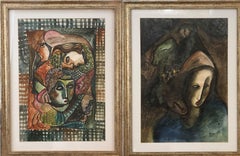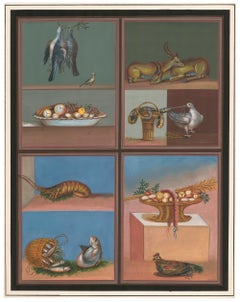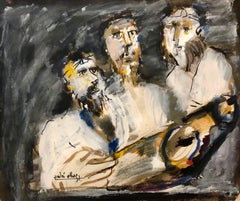Béla Kádár Art
Hungarian
Béla Kádár (1877–1956) was a Hungarian painter influenced by Der Blaue Reiter, Cubism, Futurism, Neo-Primitivism, Constructivism, and Metaphysical painting.
Kádár was born into a working-class Jewish family. After only six years of schooling he was apprenticed as an iron-turner. He began painting murals in Budapest. He visited Paris and Berlin in 1910 and by 1918 had moved to western Europe. He had his first important exhibition in October 1923 at Herwarth Walden's Galerie Der Sturm, in Berlin, showing work in an expressionist style. During the exhibition he met Katherine Dreier, who put on two exhibitions of his work at the Brooklyn Museum of Art in New York City, the second of which, in September 1928, Kádár attended.(Biography provided by Kings Gallery)
to
1
1
3
2
1
1
1
Mother and Child by Béla Kádár - Work on paper
By Béla Kádár, 1877-1955
Located in London, GB
*PLEASE NOTE UK BUYERS WILL ONLY PAY 5% VAT ON THIS PURCHASE.
Mother and Child by BÉLA KÁDÁR (1877-1955)
Gouache on paper
86 x 56.8 cm (33 7/8 x 22 3/8 inches)
Signed lower right Kádár Béla
This work is accompanied by a certificate of authenticity signed by Gábor Einspach on behalf of The First Hungarian Painting Expert's Office.
Provenance
Private collection, Israel
The Hungarian artist Béla Kádár was born in Budapest in 1877 to a working-class Jewish family. Following his father’s death, he was forced to start working from an early age after only six years to primary schooling and was apprenticed as an iron-turner. In 1902, Kádár attended the Academy of Fine Arts in Budapest. After leaving the Academy, he worked at a mural painting company. Only when he visited Berlin and Paris and being exposed to the avant-garde art of the time, did Kádár direct his attention to painting once again. In 1910, the artist won the Kohner prize, and the same year he was awarded his first solo exhibition at the Hungarian National Gallery. By 1918, Kádár moved to Western Europe. Today he is one of the most famous members of the early twentieth-century Hungarian avant-garde.
Over the course of his time living in Berlin, Kádár’s style changed. His expressionistic, graphic works were gradually replaced by paintings that were more romantic and delicate in nature. Incorporating and often synthesising stylistic elements of Cubism, Futurism, Constructivism, Neo-Primitivism and German Expressionism, Kádár’s decorative and metaphysical subject matter was often based upon traditional Hungarian folklore, and his subject-matter became increasingly narrative. His paintings in this period often feature surrealistic dream-like imagery, reminiscent of compositions by Marc Chagall. Despite his variety of subjects, ranging from abstracted figures and landscapes to interiors and objects, his paintings are typically rendered in a bright, jewel-toned palette and feature a fractured approach to rendering space.
In 1923 in Berlin, Kádár was invited by Herwath Walden to exhibit at the highly influential Galerie Der Sturm...
Category
1930s Expressionist Béla Kádár Art
Materials
Gouache
Double side portrait
By Béla Kádár, 1877-1955
Located in Jerusalem, IL
A unique piece by Hungarian artist Béla Kádár.
A double side watercolor painting featuring two beautiful scenes.
Category
Mid-20th Century Béla Kádár Art
Materials
Watercolor, Paper
Shadows
By Béla Kádár, 1877-1955
Located in West Hollywood, CA
Presenting an original mixed media watercolor by Hungarian artist Bela Kadar.
Bela Kadar was a historically important artist, is work was included as part of the degenerate art movement of Nazi Germany. His works appeared illustrated in the famous German arts magazine Der Sturm...
Category
1920s Expressionist Béla Kádár Art
Materials
Gouache
Related Items
Pompeian Still Life Gouache
Located in New York, NY
Original gouache by an unknown Neapolitan artist, circa 1840. Upper right panel after a fresco in Casa dei Dioscuri, Pompeii.
Category
1840s Béla Kádár Art
Materials
Paper, Gouache
Three Rabbis at The Torah, Expressionist Judaica Painting
By Andre Elbaz
Located in Surfside, FL
In this painting the artist uses gestural brushstrokes, which causes distortion and exaggeration for emotional effect. Andre Elbaz uses as his subject three male figures with tefilin are depicted during prayer.
André Elbaz (born April 26, 1934, El Jadida, Morocco) is a famous Moroccan painter and filmmaker.
Elbaz studied art and theatre in Rabat and Paris from 1950 to 1961. He started painting only at the age of 21, until which age he had been interested mainly in theatre. A few years later, he managed to combine his two passions into a new approach in art-therapy, inventing together with his wife, a psychiatrist, the Pictodrame, which brought him world recognition.
His first exhibition, which was very successful, took place in Casablanca in 1961 and earned him an appointment as Professor at the Beaux-Arts school in Casablanca. Years later, in 1976, he exhibited his paintings at the Tel-Aviv Museum.
In parallel to his career as a painter, Elbaz is also known as a filmmaker. He produced several short films in France, Canada and the United States. One of them, La nuit n'est jamais complète (The night is never complete), won a prize at the "5th Biennale de Paris in 1967". Among the themes chosen for the many films he produced, there was a short one about the Warsaw Ghetto uprising, as well as a series of drawings entitled Seuls (Alone), with texts written by both Elie Wiesel...
Category
20th Century Expressionist Béla Kádár Art
Materials
Paper, Gouache
Chinatown, San Francisco
By Edward Wilson Currier
Located in London, GB
'Chinatown, San Francisco', gouache on fine art paper, by Edward Wilson Currier (1903). Spofford Alley in San Francisco's Chinatown is best known for an address (number 36) where Dr. Sun Yat-Sen plotted the overthrow of China's last dynasty. During Prohibition, it was the site of turf battles over local bootlegging and protection rackets. Today it is lined with seniors' community centres. However, the quiet alley livens up in the evenings when a Chinese orchestra strikes up a tune, mah-jongg games begin with a cascade of clicking tiles, and barbers and florists use the pretence of sweeping their doorsteps to gossip. In this artist's depiction, a man smokes a long-stemmed Chinese pipe under the awning and colourful lanterns hanging from the wooden supports while a child looks on. The artwork is interesting from several standpoints including architectural, cultural and historical. Shortly after this work was painted, the neighbourhood was completely destroyed in the 1906 earthquake that levelled most of the city. From 1910 to 1940, Chinese immigrants were detained at the Angel Island...
Category
Early 1900s Expressionist Béla Kádár Art
Materials
Gouache, Paper
Sacré-Coeur Montmartre at Willette Square Paris
By Lucien Génin
Located in London, GB
'Sacré-Coeur, Montmartre at Willette Square, Paris', gouache on art paper (circa 1930s), by Lucien Génin. Created by the Director of Public Ways and Promenades under Napoleon III, Sq...
Category
1930s Expressionist Béla Kádár Art
Materials
Paper, Gouache
Untitled 743 (Abstract Painting)
By Jérémie Iordanoff
Located in London, GB
Untitled 743 (Abstract Painting)
Watercolour on paper - Unframed.
Artwork exclusive to IdeelArt.
French abstract artist Jérémie Iordanoff blends the visual languages of Western Mo...
Category
2010s Abstract Béla Kádár Art
Materials
Paper, Watercolor
Pastel Geometric Landscape in Vivid Tones, Yellow and Purple Impressionist Field
By Natalia Roman
Located in Barcelona, ES
"Pastel Geometric Landscape" is an abstract painting by Spanish artist Natalia Roman. It is a beautiful abstract architectural painting of unique blur...
Category
2010s Abstract Geometric Béla Kádár Art
Materials
Mixed Media, Oil, Acrylic, Watercolor, Archival Paper
Glassblowers WPA American Scene Mid- 20th Century Modern Figurative Workers 1932
By Harry Gottlieb
Located in New York, NY
Glassblowers WPA American Scene Mid- 20th Century Modern Figurative Workers. Dated and signed "32 Harry Gottlieb" lower right. Sight: 13 1/8" H x 18 1/4" W.
Harry Gottlieb, painter, screenprinter, educator, and lithographer, was born in Bucharest, Rumania. He emigrated to America in 1907, and his family settled in Minneapolis. From 1915 to 1917, Gottlieb attended the Minneapolis Institute of Arts. After a short stint as an illustrator for the U.S. Navy, Gottlieb moved to New York City; he became a scenic and costume designer for Eugene O"Neill's Provincetown Theater Group. He also studied at the Philadelphia Academy of Fine Arts and the National Academy of Design.
He was one of America's first Social Realist painters, influenced by that Robert Henri-led movement in New York City where Gottlieb settled in 1918. He was also a pioneer in screen printing, which he learned while working for the WPA. He married Eugenie Gershoy, and the couple joined the artist colony at Woodstock, New York. He lectured widely on art education.
In 1923, Gottlieb settled in Woodstock, New York and in 1931, spent a a year abroad studying under a Guggenheim Fellowship.
In 1935, he joined the Federal Art Project...
Category
1930s American Modern Béla Kádár Art
Materials
Paper, Gouache
Set of Twelve Antique Chinese Pith Paper Paintings of Festival Processions
Located in London, GB
Set of twelve antique Chinese pith paper paintings of festival processions
Chinese, 19th Century
Panel: Height 20cm, width 31cm
Frame: H...
Category
19th Century Béla Kádár Art
Materials
Paper, Watercolor, Wood
H 14.57 in W 19.3 in D 0.6 in
Original Painting. Colliers Magazine Cover Published 1933 Wedding Illustration
By Antonio Petruccelli
Located in New York, NY
Original Painting. Colliers Magazine Cover Published 1933 Wedding Illustration
Antonio Petruccelli (1907 - 1994)
The Wedding
Colliers published, June 17, 1933
17 1/4 X 11 1/2 inches (sight)
Framed 23 1/4 X 17 1/2 inches
Gouache on board
Signed lower right
BIOGRAPHY:
Antonio Petruccelli (1907-1994) began his career as a textile designer. He became a freelance illustrator in 1932 after winning several House Beautiful cover illustration contests.
In addition to 24 Fortune magazine covers, four New Yorker covers, several for House Beautiful, Collier’s, and other magazines he did numerous illustrations for Life magazine from the 1930s – 60s.
‘Tony was Mr. Versatility for Fortune. He could do anything, from charts and diagrams to maps, illustrations, covers, and caricatures,’ said Francis Brennan, the former art director for Fortune.
Over the course of his career, Antonio won several important design awards, designing a U.S. Postage Stamp Commemorating the Steel Industry and designing the Bicentennial Medal...
Category
1930s American Realist Béla Kádár Art
Materials
Board, Gouache
Emile's Tavern
By Lucien Génin
Located in London, GB
'Emile's Tavern', gouache on paper (circa 1930s), by Lucien Génin. A tavern in French is called a 'guinguette'. With the rise in living standards from the 1860s along with the develo...
Category
1930s Expressionist Béla Kádár Art
Materials
Paper, Gouache
"Vertical Plane II" abstract painting on paper geometric, stacked shapes bright
By Amanda Andersen
Located in Hamburg, HH
One in a series of three abstract paintings made in 2023 by Amanda Andersen, initialed on the back.
An array of loose geometric shapes: rectangles, triangles and circles converse wi...
Category
2010s Abstract Geometric Béla Kádár Art
Materials
Paper, Acrylic, Gouache, Color Pencil
Amanda Andersen"Vertical Plane II" abstract painting on paper geometric, stacked shapes bright, 2023
H 19.69 in W 27.56 in D 0.04 in
Art Deco Costume Design - Eva
By Georges Lepape
Located in Miami, FL
The paper in some of these photos looks overly textured due to the sharpness of the high-res digital camera.
In person, with the human eye, the paper looks reasonably smooth with out blemishes.
For this fashion illustration, Georges Lepape paints a stunning abstract pattern for the subject dress that is repeated in her hair. The work represents an early use of metallic paint, with silver metallic in the dress and bronze metallic in the blouse. Lepape's highly detailed drawing becomes more evident the closer you look. It's quite amazing how deftly he rendered facial feature on such a small scale. "Eva" 1918 Gouache, watercolor, and ink on paper Signed and dated, lower right: '1918' Inscribed, verso: "Costume for L'enfantement du mort, (miracle en pourpre, et or.). Devised by Marcel L'Herbier and performed at the Théatre Edouard VII and the Comédie des Champs-Elysées, 1919" Provenance: Ex-collection Lucien...
Category
1910s Art Deco Béla Kádár Art
Materials
Ink, Gouache, Paper, Watercolor, Pencil
Béla Kádár art for sale on 1stDibs.
Find a wide variety of authentic Béla Kádár art available for sale on 1stDibs. You can also browse by medium to find art by Béla Kádár in paint, paper, watercolor and more. Much of the original work by this artist or collective was created during the 20th century and is mostly associated with the modern style. Not every interior allows for large Béla Kádár art, so small editions measuring 10 inches across are available. Customers who are interested in this artist might also find the work of Albert Bertalan, Pierre Ambrogiani, and Alfred Kubin. Béla Kádár art prices can differ depending upon medium, time period and other attributes. On 1stDibs, the price for these items starts at $5,884 and tops out at $24,410, while the average work can sell for $9,141.




